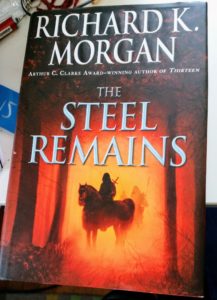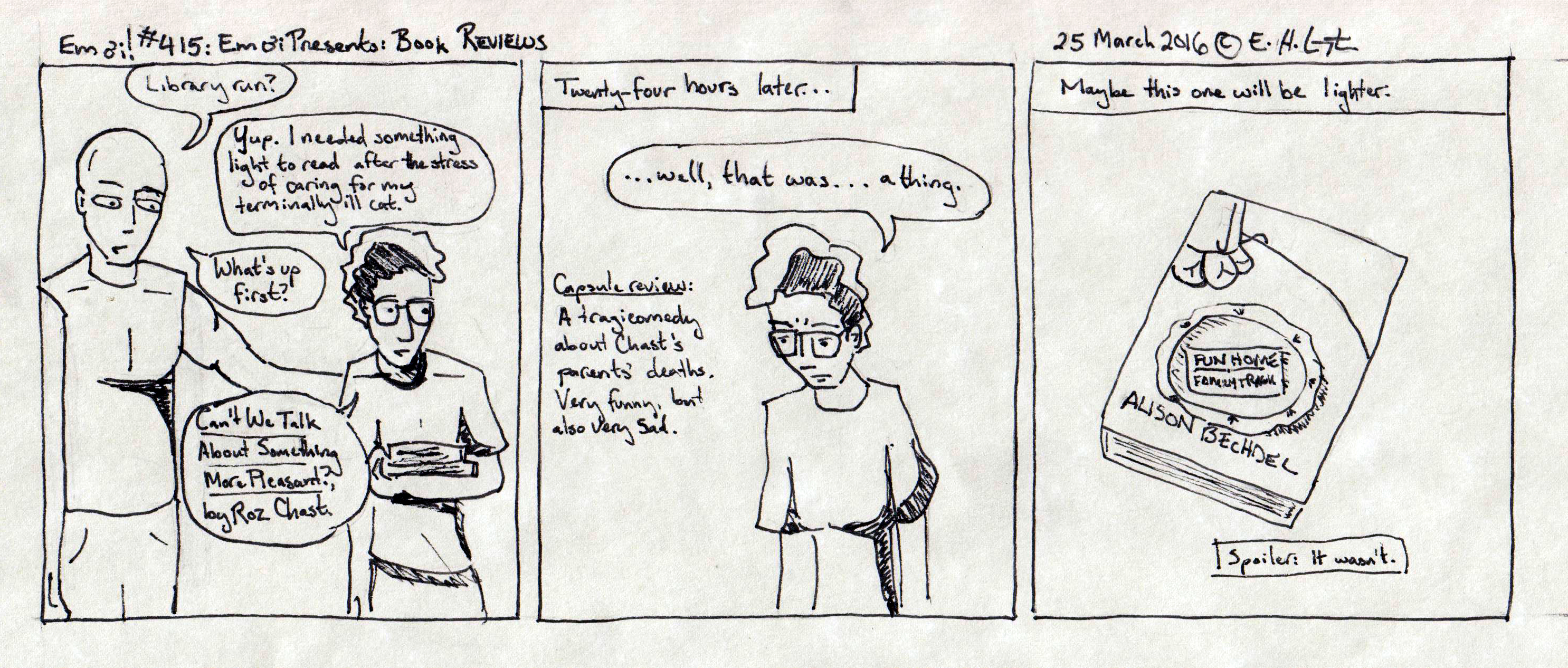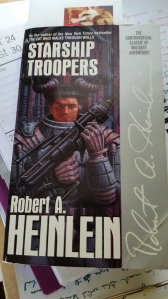Brooks, Max. World War Z: An Oral History of the Zombie War: The Complete Edition. Read by Max Brooks et al. Abridged edition. New York: Random House Audio, 2013. MP3, 61 files, 12:12:26.
Max Brooks must have been the victim of the most liberal of liberal educations; everywhere in this book are concerns about capitalism, oligarchies, religion, imperialism and colonization, international relations, race and racism.
Let me back up. This audio book, a full-cast performance of Brooks’s World War Z, was recommended to me by some friends in part because of the all-star cast; characters are played by the likes of Nathan Fillion, Mark Hamill, Jeri Ryan, Rob Reiner, Alan Alda, Common, Simon Pegg, and Martin Scorcese, to name a few. Since the book is set up as a series of interviews, the various narrators work really well (with a few exceptions, which I’ll come to in a minute). The effect was more like a radio play than audio books typically are, and in general I really enjoyed it.
World War Z is a survivors’ tale—it follows an unnamed narrator (voiced by Brooks) as he journeys around the world to interview and record the stories of those who fought in the zombie war, so from the start you know that humanity made it through, and that things are, in a certain sense of the term, all right again. The zombies here are your typical living dead: slow, shuffling, intent on eating any life-forms they encounter. Brooks is not interested in, and in fact explicitly rejects, any attempts to humanize the zombies. He doesn’t delve too far into how the plague appears, though he implies that it is related to the Three Gorges Dam project. He also seems clear that “the plague” is a virus, but doesn’t spend much time dwelling on the idea of treatment or a cure.[1] His characters ask questions about the weirder points of zombies as he sees them, like how they can be frozen and reanimate when thawed, or how they can walk on the ocean floor at depths far beyond what a human should be able to tolerate, but there are no answers provided.
The intriguing thing about WWZ is that it’s not just mindless genre fiction[3]; Brooks really uses his characters to land a number of solid and well-deserved blows against humanity, and the US especially. Zombies are actually really interesting this way—they reflect a lot of different neuroses or fears: they can be metaphors for capitalism or consumerism, represent our fears of our own inevitable deaths and the problems with a desire for immortality, or showcase a desire for a radical shake-up of society. Unlike natural disasters, which hit only a limited area, or even diseases or economic collapse, both of which are manageable if you have sufficient privilege (money), zombies are a nondiscriminatory evil. I don’t think it’s a coincidence that as the recession started there was a zombie obsession in the US. Zombies represent the ultimate stock market crash, one where you never have to face paying off your credit card after you’ve lost your job.[4]
Although Brooks’s narrator tries to be objective, the book as a whole seems to be relentlessly Marxist. Some of the things Arthur Sinclair (leader of the US resource-management program, played by Alan Alda) comes up with, about people doing useful labor and feeling pride in the things they made, seem to come directly from The German Ideology. Brooks has strong criticisms of capitalism in the character of an unrepentent entrepreneur who used Dr. Oz-like canny to sell Americans a bunch of snake-oil vaccines before absconding to Antarctica to wait out the plague. Brooks is also strongly critical of coercive forms of government; under his projections, China becomes a democracy (United Federation of China), and he has a lot of harsh words for the old guard as they leave; Cuba becomes a democracy too, and he has nothing but scorn for the newly created Holy Russian Empire (primarily because of its co-option of [genuine?] religious sentiment to push a totalitarian agenda). In fact, it wouldn’t be out of place to say that he’s generally somewhat misanthropic, though some of the characters fare better than others. He also digs in deep to give a really diverse view of the problem; although there’s strong representation from the US, the story is also peppered with a South African military planner, a Chinese doctor and a sailor, a Sri Lankan translator, an Indian army engineer, and a variety of other people from the global south. He even manages to get a wheelchair-bound guy and a blind man in. In terms of representation, he’s batting a million.[5]
The cast was generally great, though—and I guess other reviewers have pointed this out as well—Steve Park cannot do a Chinese accent to save his life.[6] The characters are a mixed bag. Brooks is particularly interested in the blue collar, working class, soldier-level view, so while we hear from a few individuals who held positions of authority during the war, most of the speakers were or are army grunts, hired help, suburban homeowners, and others who are essentially powerless (or see themselves as such) in the face of “the system.” He even interviews the vice president, but not the president. I will say that in amongst all the scorn, Israel gets off pretty easy (having self-quarantined at the beginning of the outbreak, they suffered a civil war led by the ultra orthodox, but wound up reuniting with the Palestinians); however, I have to admit I found the character of the Palestinian teenager who believes the plague warnings are Israeli propaganda designed to lure Arabs to their deaths (until he sees the zombies for himself) was a very compelling character.
More troublesome in amongst Brooks’s misanthropy was his borderline misogyny. A lot of the female characters in the book are harpies, or else individuals who need men to save them. The first woman we meet, Mary Jo Miller (played by Denise Crosby, also known as Tasha Mutherfuckng Yar), is an unpleasant suburban woman in a loveless relationship with her husband who seems to hate her children and who comes off as really unintelligent and uninteresting. She’s said, at the time we meet her, to have become a developer making zombie-proof compounds, but the transformation from cliche housewife to entrepreneur is not chronicled. In another scene, we listen to a young woman (Jesika Hendricks, played by Michelle Kholos) recount a story in which, while her family is starving through a Canadian winter and she is on the verge of death, her mother bullies her father into trading a radio for some stew[7] by calling him a number of unpleasant names, including the f-word. This I cannot profess to understand; if your child is starving and you need meat, you don’t need to ask your husband to go get it; you as an adult human being are capable of making that decision and trading the radio yourself. Another woman is said to have the mind of a four-year-old child, owing to traumatic events in her past.[8] Maybe I’m just resentful that the men, even the male characters who were kind of scumbags, all seemed to have sweeping plot lines and interesting, exciting ideals they were clinging to (and make surprisingly few references to wives, girlfriends, or other females that populate most men’s lives), while the women seemed largely motivated by their husbands, children, and in one case by her mother issues, and they were almost all in need of rescue rather than being the rescuers. Yawn.
Science fiction and horror books can often be read as inherently regressive. Technology is dangerous, they seem to say; just look at what it has caused. Certainly by waving a blaming finger in the direction of the Three Gorges dam, Brooks seems to be saying the same thing with his zombies. But he doesn’t dwell on the technological aspect of things—the dam may have caused the problem (or perhaps not), but the real issue once the plague begins is humanity’s damn inability to stop fighting with itself and get on with fighting the real enemy. One former Iranian pilot describes the outbreak of nuclear war between Iran and Pakistan because the governments were unable to communicate; a Chinese naval officer describes having to blow up a submarine that spent valuable time and resources tracking down his sub after he defected; a US army grunt (Todd Wainios, played by an extremely effective Mark Hamill) describes being caught absolutely unprepared and overrun by the enemy at the Battle of Yonkers. The grunts typically understand the tactical errors and idiocy of their superiors; over and over, the general story seems to be “the government made decisions that seemed unethical/unintelligent/impossible, but I was powerless to change it.” Even in the face of the total collapse of the world’s systems, individuals are still largely disenfranchised. Scary stuff.
After all that, my favorite section, the one that nearly moved me to tears, was the interview with Darnell Hackworth, voiced by Common.[9] Hackworth runs a retirement facility for former zombie sniffer dogs; he describes the process of training them and the bond he shares with his partner, a now-elderly dachshund mix named Masie (“Maze”). In the midst of a long, long story entirely about man’s inhumanity to man (both in the inhumanity of the zombies and the stupidity of the various crises), the bond between man and dog really stuck out to me. Perhaps it’s because I’m a sentimental animal lover myself, but the clear affection between man and beast stuck out as a wonderful, caring, normal moment in a sea of other unsettling details.
I don’t mean to sound entirely uncritical, since there were a few plot holes that never seemed to be well-explained to me—chief among them that the zombies freeze in the winter. How many zombies can you kill in a day if they’re frozen? Seems like that could cut down on the problem right there.[10] It’s worth noting that there were a lot of gory if clinical descriptions of zombies that turned my stomach. And certainly the weirdest moment involved Todd Wainios’s description of the liberation of Janesville, Wisconsin. That was kind of a “What the ever-loving fuck” sort of moment.
Sometimes, really great works of genre fiction transcend their genre and become something larger. World War Z is trying really hard to get there. I think it almost makes it. Scathing political commentary aside, it’s got some fun stories, a solid meta-narrative, and it’s also really thought-provoking. In a bad way. By which I mean that after a few days of listening to the story, I started looking around my house and making assessments: too many large windows at ground level—a great selling point when we bought the place, but not great for securing the building. Our fence is only six feet tall and chain-link, built for keeping dogs in rather than keeping zombies out. Our dogs are not really guard dogs and, while they might bark when zombies approach, they also bark when the neighbor goes outside, or sometimes just because they have dog brains and they bark for no reason. I am not really good at keeping plants alive, so growing our own food sounds difficult if not impossible (also there’s six months of winter here). Neither of us can fire a gun. If the economy collapses, my main skills are running long distances and speaking other languages, and B is a computer programmer. We are totally doomed. Doomed.
[1] My understanding is that his first book, the 2002 Zombie Survival Guide, mentioned a few ideas about curing the very recently infected and generally dismissed the idea as untenable—although he notes that in some cases, amputation of the bitten limb may have worked? (This is all based on the book’s wikipedia summary.) Which also makes me wonder about amputation as a treatment for rabies. Sorry, this is a digression.[2]
[2] OKAY I looked it up and it’s actually really neat. So the rabies virus—unlike other viruses, like HIV, which are blood-borne—actually hitches its way up the nerve axons from the place where a victim is bitten to the brain (where it kills you through a mechanism that is still not understood DESPITE HUMAN RABIES CASES GOING BACK TO THE BEGINNING OF RECORDED HISTORY). Thing is, this nervous-system travel is really slow, so if you cut off the affected limb, you can effectively cure the infection. One mouse study found that amputation within eighteen days of infection was sufficient. See G.M. Baer and W.F. Cleary, “A Model in Mice for the Pathogenesis and Treatment of Rabies,” Journal of Infectious Diseases 125, no. 5 (1972): 520–527, http://www.jstor.org/stable/30110879. So the question becomes now: are zombieism (and related conditions perhaps, like lycanthropy) blood-borne diseases like HIV, or do they move along the nervous system like rabies? The literature is remarkably silent on this point (although check this thread on the Straight Dope message board for some opinions). (Future PhD thesis topic anyone? You’re welcome.)
[3] No one is criticizing mindless genre fiction, I’m just not writing about it.
[4] When I bought a house, I read somewhere that a house is basically just an interconnected series of systems—electricity, water, gas, heat, walls/windows (the point being that keeping it in one piece, an intimidating idea for a first-time homeowner, is actually not so bad—you just keep the various systems going). The country as a whole, even the world, are all actually composed of interconnected systems: the delivery of utilities (water, electricity, the internet, natural gas), provision of security, shipping (gas to gas stations, food to stores, parts to factories), the economic system, the health-care system, schools, the roads—a million nodes in public and private networks that work together to make things happen on a day-to-day basis. The substructure, as Marx would say. And I guess the point of a rapidly spreading highly deadly “plague” like that experienced in WWZ is that it overwhelms and crashes a bunch of the systems at once worldwide, versus smaller-scale catastrophes that might crash only one of the systems on a less-than-global scale.
[5] Strikingly, North Korea is mentioned but does not appear; it appears the entire population of the DPRK has vanished. It is suggested that they are underground. (This is rumored to actually be possible.)
[6] In my version of the recordings, there’s also a weird part at the end where a few of the characters sort of inexplicably read the narration to their parts, making the whole thing sound like this. Maybe this got fixed in other releases?
[7] Strongly implied to be human stew.
[8] I didn’t buy this section, for a number of reasons. And she didn’t talk like any four year old I’ve ever met.
[9] Yeah, I know about him because he was on the Nightly Show a few days ago. Seems like a smart fellow.
[10] Wainios suggests the snow is so deep that it’s hard to find them all. Not sure I buy that explanation.






